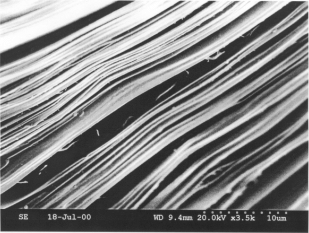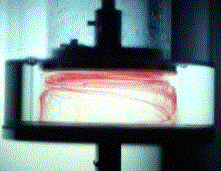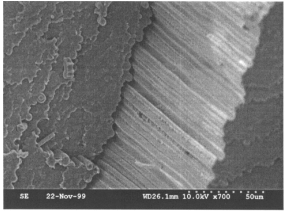Smart (Controllable) Blending and Novel Morphologies Produced by Chaotic
Advection
In the Third Millennium, we need to move beyond uncontrollable
blending when making plastics, extrusions of various types, and certain
high-value added fiber and film products. Currently, polymer blends are
formed with little means to obtain desired shapes among components (e.g.,
of melts A and B) during mixing steps. Blend morphology is for the most
part an uncontollable outcome so that extrusions or injection-molded parts
are rarely optimized with regard to structure-property relations.
Most often, composition strongly governs morphology. It is preferable to
promote and retain specific shapes over wide ranges in composition  within polymer melts to effect desired properties. Fiber glass,
for example, would be worthless if the glass fibers were chopped into
bits and then added to the matrix component! What if we could blend two
or more polymers and deliberately convert them in doing so to multi-layers,
platelets, fibers, or other shapes? We are doing this in the LAPM&T
to create plastic products with enhanced properties and also develop processes
that are controllable. Multilayer films have been produced that
consist of thousands of individual layers with layer thicknesses in some
cases below 200 nanometers. Fibers have also been extruded that contain
thousands of internal fibers. The multi-layers and internal fibers
were formed directly and controllably in multicomponent melts subjected
to chaotic advection (also sometimes referred to as chaotic mixing) conditions.
Thermoplastic composites have also been produced in this manner with particulate
and fiber additives to yield electrically conducting and fiber-reinforced
materials. In these materials, percolating structures were in essence constructed
in lieu of being the outcome of random associations among additives.
within polymer melts to effect desired properties. Fiber glass,
for example, would be worthless if the glass fibers were chopped into
bits and then added to the matrix component! What if we could blend two
or more polymers and deliberately convert them in doing so to multi-layers,
platelets, fibers, or other shapes? We are doing this in the LAPM&T
to create plastic products with enhanced properties and also develop processes
that are controllable. Multilayer films have been produced that
consist of thousands of individual layers with layer thicknesses in some
cases below 200 nanometers. Fibers have also been extruded that contain
thousands of internal fibers. The multi-layers and internal fibers
were formed directly and controllably in multicomponent melts subjected
to chaotic advection (also sometimes referred to as chaotic mixing) conditions.
Thermoplastic composites have also been produced in this manner with particulate
and fiber additives to yield electrically conducting and fiber-reinforced
materials. In these materials, percolating structures were in essence constructed
in lieu of being the outcome of random associations among additives.
Examples are shown below
of some structured polymeric materials and computer-generated results.
In the upper left, a very highly multilayered film morphology is shown.
The film layers were formed from polymer melt streams in a continuous chaotic
advection blender, also known as a smart blender or chaotic blender, and
extruded as filaments. Similar layered structures have also been extruded
in film form. In the color image, conditions to instill 3D chaotic advection
throughout a cavity intended for polymer processing were ascertained using
pigmented fluids. Results were cross-checked with computational fluid
mechanics models. In the right upper figure, a computational simulation
is shown of a circular blob converted to a folded film (shown in cross-section).
Subsequent modeling and experiments showed that the films multiplied by
repeated stretching and folding and fragmented in some cases to yield abundant
fibers. For example, very many internal fibers are shown within an extruded
filament in the lower left figure. In the lower center figure,
percolating networks were constructed among carbon black particles to render
polystyrene electically conducting. Chaotic advection organized the
particle additives into long branched filaments such that interconnections
were promoted. In the lower right picture that was generated computationally,
a droplet acted as a type of internal stirrer and improved mixing uniformity
by collapsing an island where mixing conditions were poor. While our studies
are focused on the development of new polymer processes and materials,
fundamentals of general importance to blending and chaotic mixing such
as those related to the effects of interfaces among melt components are
also addressed.
The demand for products with particular characteristics
increases on a daily basis. Manufacturers must meet the specific needs
of customers which may change monthly. Our studies in chaotic advection
have demonstrated that shapes among components can be controllably evolved.
Often, for example, large blobs are converted to sheets which refine
to multi-layers. Morphological transitions among the layers can lead to
many other shapes-many of which may be useful. Notably, many of these morphologies
are not observed in common blending equipment since they may only appear
locally within devices and as short-lived transitional structures.
In our processes, however, desired shapes can be constructed in situ and
delivered to dies for extrusion. Controllable blending methods can make
effective use of molecules that are synthesized to have particular processing
characteristics and properties. And of course, with controllable
blending technologies, manufacturers can optimize products on-line by also
using instrumentation and control technologies. We feel that the time has
come to move beyond uncontrollable blending and onward to Smart Blending
practices.
[HOME] [Mission]
[Research] [Position]
[Publication] [Gallery]






 within polymer melts to effect desired properties. Fiber glass,
for example, would be worthless if the glass fibers were chopped into
bits and then added to the matrix component! What if we could blend two
or more polymers and deliberately convert them in doing so to multi-layers,
platelets, fibers, or other shapes? We are doing this in the LAPM&T
to create plastic products with enhanced properties and also develop processes
that are controllable. Multilayer films have been produced that
consist of thousands of individual layers with layer thicknesses in some
cases below 200 nanometers. Fibers have also been extruded that contain
thousands of internal fibers. The multi-layers and internal fibers
were formed directly and controllably in multicomponent melts subjected
to chaotic advection (also sometimes referred to as chaotic mixing) conditions.
Thermoplastic composites have also been produced in this manner with particulate
and fiber additives to yield electrically conducting and fiber-reinforced
materials. In these materials, percolating structures were in essence constructed
in lieu of being the outcome of random associations among additives.
within polymer melts to effect desired properties. Fiber glass,
for example, would be worthless if the glass fibers were chopped into
bits and then added to the matrix component! What if we could blend two
or more polymers and deliberately convert them in doing so to multi-layers,
platelets, fibers, or other shapes? We are doing this in the LAPM&T
to create plastic products with enhanced properties and also develop processes
that are controllable. Multilayer films have been produced that
consist of thousands of individual layers with layer thicknesses in some
cases below 200 nanometers. Fibers have also been extruded that contain
thousands of internal fibers. The multi-layers and internal fibers
were formed directly and controllably in multicomponent melts subjected
to chaotic advection (also sometimes referred to as chaotic mixing) conditions.
Thermoplastic composites have also been produced in this manner with particulate
and fiber additives to yield electrically conducting and fiber-reinforced
materials. In these materials, percolating structures were in essence constructed
in lieu of being the outcome of random associations among additives.





